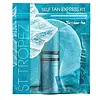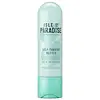What's inside
What's inside
 Key Ingredients
Key Ingredients

 Benefits
Benefits

 Concerns
Concerns

 Ingredients Side-by-side
Ingredients Side-by-side

Dihydroxyacetone
Skin ConditioningCaramel
Cosmetic ColorantPropylene Glycol
HumectantEthoxydiglycol
HumectantGlycerin
HumectantPPG-5-Ceteth-20
EmulsifyingDecyl Glucoside
CleansingPhenoxyethanol
PreservativeParfum
MaskingMelanin
Skin ProtectingCetyl Hydroxyethylcellulose
Emulsion StabilisingDimethyl Isosorbide
SolventSodium Metabisulfite
AntioxidantEthylhexylglycerin
Skin ConditioningLinalool
PerfumingBenzyl Salicylate
PerfumingCI 14700
Cosmetic ColorantHexyl Cinnamal
PerfumingCI 19140
Cosmetic ColorantCitronellol
PerfumingCI 42090
Cosmetic ColorantLimonene
PerfumingAloe Barbadensis Leaf Juice
Skin ConditioningGeraniol
PerfumingCoumarin
PerfumingAlpha-Isomethyl Ionone
PerfumingHydroxycitronellal
PerfumingPotassium Sorbate
PreservativeCitric Acid
BufferingDihydroxyacetone, Caramel, Propylene Glycol, Ethoxydiglycol, Glycerin, PPG-5-Ceteth-20, Decyl Glucoside, Phenoxyethanol, Parfum, Melanin, Cetyl Hydroxyethylcellulose, Dimethyl Isosorbide, Sodium Metabisulfite, Ethylhexylglycerin, Linalool, Benzyl Salicylate, CI 14700, Hexyl Cinnamal, CI 19140, Citronellol, CI 42090, Limonene, Aloe Barbadensis Leaf Juice, Geraniol, Coumarin, Alpha-Isomethyl Ionone, Hydroxycitronellal, Potassium Sorbate, Citric Acid
Water
Skin ConditioningDihydroxyacetone
Skin ConditioningDimethicone
EmollientCyclopentasiloxane
EmollientCetearyl Alcohol
EmollientC12-15 Alkyl Benzoate
AntimicrobialCaprylic/Capric Triglyceride
MaskingCyclohexasiloxane
EmollientGlyceryl Stearate
EmollientIsopropyl Myristate
EmollientPEG-100 Stearate
Magnesium Aluminum Silicate
AbsorbentErythrulose
TanningCI 77891
Cosmetic ColorantTocopheryl Acetate
AntioxidantAgastache Mexicana Flower/Leaf/Stem Extract
Skin ConditioningAloe Barbadensis Extract
Skin ConditioningAscorbic Acid
AntioxidantCitrus Grandis Peel Oil
MaskingCocos Nucifera Oil
MaskingMica
Cosmetic ColorantEucalyptus Globulus Leaf Oil
PerfumingMentha Piperita Oil
MaskingPanthenol
Skin ConditioningPersea Gratissima Oil
Skin ConditioningSalvia Hispanica Seed Oil
MoisturisingSalvia Officinalis Oil
MaskingTropaeolum Majus Flower/Leaf/Stem Extract
Skin ConditioningPropanediol
SolventPropylene Glycol
HumectantGlycerin
HumectantParfum
MaskingBenzophenone-4
UV AbsorberEthylhexylglycerin
Skin ConditioningLactic Acid
BufferingPEG-40 Hydrogenated Castor Oil
EmulsifyingLinalool
PerfumingMethoxyphenyl T-Butylphenyl Propanediol
Skin ConditioningPhenoxyethanol
PreservativeTriethylene Glycol
MaskingCI 16035
Cosmetic ColorantCI 19140
Cosmetic ColorantWater, Dihydroxyacetone, Dimethicone, Cyclopentasiloxane, Cetearyl Alcohol, C12-15 Alkyl Benzoate, Caprylic/Capric Triglyceride, Cyclohexasiloxane, Glyceryl Stearate, Isopropyl Myristate, PEG-100 Stearate, Magnesium Aluminum Silicate, Erythrulose, CI 77891, Tocopheryl Acetate, Agastache Mexicana Flower/Leaf/Stem Extract, Aloe Barbadensis Extract, Ascorbic Acid, Citrus Grandis Peel Oil, Cocos Nucifera Oil, Mica, Eucalyptus Globulus Leaf Oil, Mentha Piperita Oil, Panthenol, Persea Gratissima Oil, Salvia Hispanica Seed Oil, Salvia Officinalis Oil, Tropaeolum Majus Flower/Leaf/Stem Extract, Propanediol, Propylene Glycol, Glycerin, Parfum, Benzophenone-4, Ethylhexylglycerin, Lactic Acid, PEG-40 Hydrogenated Castor Oil, Linalool, Methoxyphenyl T-Butylphenyl Propanediol, Phenoxyethanol, Triethylene Glycol, CI 16035, CI 19140
Ingredients Explained
These ingredients are found in both products.
Ingredients higher up in an ingredient list are typically present in a larger amount.
CI 19140 is also known as Tartrazine. Tartrazine is a synthetic dye used in cosmetics, foods, and medicine to add a yellow color.
Tartrazine is created from petroleum and is water-soluble.
Some people may experience allergies from this dye, especially asthmatics and those with an aspirin intolerance.
Learn more about CI 19140Dihydroxyacetone, or DHA, is a simple sugar. It is frequently used in self-tanning products.
DHA binds to the amino acids in your dead skin cells to create a brown/orange color. Darkening begins to kick in a few hours after application and will continue to develop for up to 3 days. This ingredient can be drying.
Both the US and the EU have approved DHA in self-tanning products. In the EU, DHA is allowed at a maximum concentration of 10%. Most tanning products usually contain amounts between 3-5%.
If you are pregnant or have underlying medical conditions, it is best to speak with a dermatologist about using self-tanning products.
Learn more about DihydroxyacetoneEthylhexylglycerin (we can't pronounce this either) is commonly used as a preservative and skin softener. It is derived from glyceryl.
You might see Ethylhexylglycerin often paired with other preservatives such as phenoxyethanol. Ethylhexylglycerin has been found to increase the effectiveness of these other preservatives.
Glycerin is already naturally found in your skin. It helps moisturize and protect your skin.
A study from 2016 found glycerin to be more effective as a humectant than AHAs and hyaluronic acid.
As a humectant, it helps the skin stay hydrated by pulling moisture to your skin. The low molecular weight of glycerin allows it to pull moisture into the deeper layers of your skin.
Hydrated skin improves your skin barrier; Your skin barrier helps protect against irritants and bacteria.
Glycerin has also been found to have antimicrobial and antiviral properties. Due to these properties, glycerin is often used in wound and burn treatments.
In cosmetics, glycerin is usually derived from plants such as soybean or palm. However, it can also be sourced from animals, such as tallow or animal fat.
This ingredient is organic, colorless, odorless, and non-toxic.
Glycerin is the name for this ingredient in American English. British English uses Glycerol/Glycerine.
Learn more about GlycerinLinalool is a fragrance and helps add scent to products. It's derived from common plants such as cinnamon, mint, citrus, and lavender.
Like Limonene, this ingredient oxidizes when exposed to air. Oxidized linalool can cause allergies and skin sensitivity.
This ingredient has a scent that is floral, spicy tropical, and citrus-like.
Learn more about LinaloolParfum is a catch-all term for an ingredient or more that is used to give a scent to products.
Also called "fragrance", this ingredient can be a blend of hundreds of chemicals or plant oils. This means every product with "fragrance" or "parfum" in the ingredients list is a different mixture.
For instance, Habanolide is a proprietary trade name for a specific aroma chemical. When used as a fragrance ingredient in cosmetics, most aroma chemicals fall under the broad labeling category of “FRAGRANCE” or “PARFUM” according to EU and US regulations.
The term 'parfum' or 'fragrance' is not regulated in many countries. In many cases, it is up to the brand to define this term.
For instance, many brands choose to label themselves as "fragrance-free" because they are not using synthetic fragrances. However, their products may still contain ingredients such as essential oils that are considered a fragrance by INCI standards.
One example is Calendula flower extract. Calendula is an essential oil that still imparts a scent or 'fragrance'.
Depending on the blend, the ingredients in the mixture can cause allergies and sensitivities on the skin. Some ingredients that are known EU allergens include linalool and citronellol.
Parfum can also be used to mask or cover an unpleasant scent.
The bottom line is: not all fragrances/parfum/ingredients are created equally. If you are worried about fragrances, we recommend taking a closer look at an ingredient. And of course, we always recommend speaking with a professional.
Learn more about ParfumPhenoxyethanol is a preservative that has germicide, antimicrobial, and aromatic properties. Studies show that phenoxyethanol can prevent microbial growth. By itself, it has a scent that is similar to that of a rose.
It's often used in formulations along with Caprylyl Glycol to preserve the shelf life of products.
Propylene Glycol is an odorless, colorless liquid. As a humectant, it helps skin retain moisture. It also aids in delivering active ingredients.
Another role of this ingredient is preventing a product from melting or freezing. Propylene glycol also adds antimicrobrial properties to a product, elongating product lifespan.
This ingredient is considered an organic alcohol and commonly added into both cosmetics and foods.
Those with sensitive skin or conditions may develop a rash when using this ingredient.
Learn more about Propylene Glycol